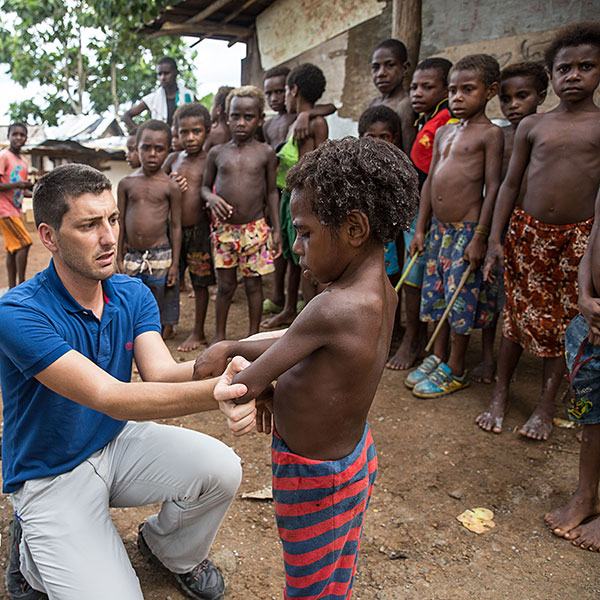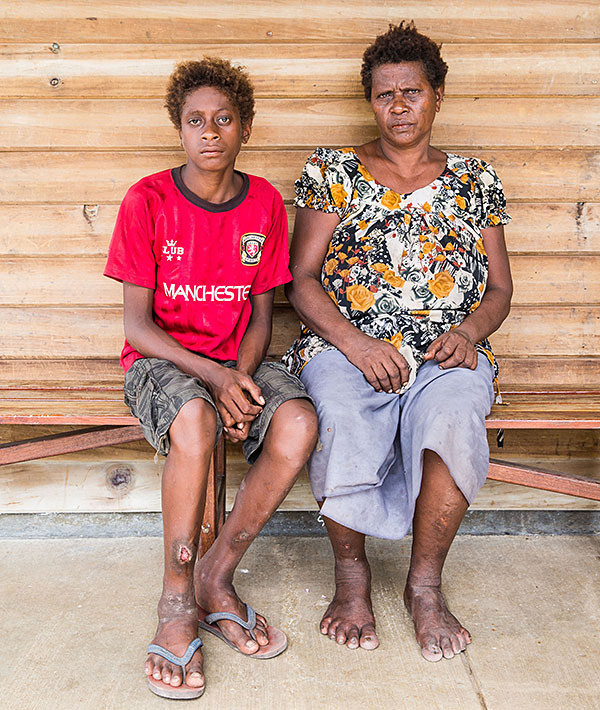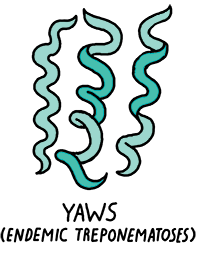Papua New Guinea struggles to eradicate yaws disease

Roula Khalaf, Editor of the FT, selects her favourite stories in this weekly newsletter.
At first the lump on Timish Ongula’s right leg was barely noticeable, but within six weeks it had developed into a painful, golf ball-sized ulcer that oozed pus and blood, making it difficult for the four-year-old girl to walk. “Timish cried a lot and had a lot of trouble sleeping. The sore grew so fast that we took her to the hospital to get medical treatment,” says Noreen Brast, her mother. “Thank God we did.”
Timish lives at Landolam migrant settlement, a collection of ramshackle wooden huts on Lihir, a tiny tropical island in the south-west Pacific a two-hour flight from Port Moresby, the capital of Papua New Guinea. Her family is one of many to have moved to Lihir from other parts of the country, lured by work in a local gold mine and its surrounding markets. She was diagnosed with yaws, a disease that affects hundreds of thousands of people living in the world’s poorest countries.
Yaws is caused by the bacteria Treponema pallidum, another variety of which causes syphilis. Yaws is spread via skin contact rather than sex, however, and typically affects children, who are more prone to cuts and scratches that become infected with the bacteria. It is especially prevalent among those who live in crowded and unsanitary conditions. In its initial stages it causes lesions on the skin, but left untreated, it can lead to disability and deformity.
Yaws is not difficult to treat: just one tablet of an antibiotic, azithromycin, costing about $0.17, is enough. This is what Timish received and “the ulcer improved very fast”, according to her doctor, Oriol Mitjà. “After two days the ulcer stopped oozing and bleeding, which indicates that the bacteria have disappeared, and after two weeks there was complete wound healing.”
Mitjà has been working at the Lihir medical centre (a facility run jointly by the government and private funding) since 2010 and his research has reignited interest in yaws among global health authorities. It was Mitjà’s discovery in 2012 that a single tablet of azithromycin was as effective as the traditional treatment for yaws — an injection of the antibiotic benzathine penicillin — that persuaded the World Health Organisation to design a new strategy the same year to eradicate the disease all over the world by 2020.
“Mitjà’s discovery was of great significance, as it makes large-scale treatment of affected populations more practical,” says Kingsley Asiedu, the doctor responsible for the WHO eradication campaign. “A dose of azithromycin is cheap and easy to administer. Injections are much more cumbersome as they require administration by healthcare workers and cause a lot of pain for the children.”
If it works, this WHO campaign will be only the second ever to result in the successful eradication of a human pathogen. Smallpox, its only success to date, was officially declared eradicated after a global campaign in 1980. But five years after the yaws strategy was launched, the WHO has run into the twin obstacles of a lack of drugs and one of funding. The organisation initiated talks with Pfizer, the pharmaceuticals multinational and manufacturer of azithromycin, over the possible donation of tablets in 2012, but so far these efforts have come to nothing, says Asiedu. “The 2020 timeline is not going to happen now. We have not made the progress we anticipated back in 2012,” he says.

This is not the first time the WHO has tried to eradicate yaws. A previous attempt between 1952 and 1964 was unsuccessful. At that time, health workers treated about 50m cases across 46 countries by administering injections of penicillin. By the end of the campaign, the number of cases dropped by 95 per cent to 2.5m, but as the incidence declined, healthcare authorities redirected their attention elsewhere. “Funds dried up, staff moved on to other jobs and surveillance programmes were discontinued, so no one knew how many cases there were,” says David Mabey, professor of communicable diseases at the London School of Hygiene and Tropical Medicine. “Yaws was forgotten.”
At Lihir medical centre, where Timish is now able to take part in running races with her friends, the consequences of failing to treat the disease quickly are plain to see. Nine-year-old Stanis Malome caught the disease three years ago but did not seek medical attention. The infection has now spread to his shin bone, which is badly misshapen and protrudes out of the skin on his leg, causing a permanent open wound. “I left school because of the sore. It’s hard to walk,” Stanis says. He will live with the disability for the rest of his life.
Mitjà says such cases demonstrate why the global campaign must be rolled out speedily and effectively. “The treatment is so simple, cheap and effective that there is every reason we can achieve this target,” he says. “But it takes a global commitment.”

Today, the disease is endemic in 13 countries in west Africa, Asia and the Pacific but it may also be present in other poor countries that do not report cases to the WHO. About 90m people are thought to live in exposed areas. So far, the WHO has funded pilot studies in five endemic countries: Papua New Guinea, Congo, Ghana, the Solomon Islands and Vanuatu. Initial results have been promising, showing that providing a dose of azithromycin to every person in a community whether thought to be infected or not — a strategy known as total community treatment (TCT) — can dramatically cut disease prevalence.
By contrast, in the 1950s, only “active” cases of yaws were targeted. In latent cases, where bacteria were present in the body but did not show noticeable symptoms, the infection was able to recur resulting in a rapid return of the disease. With TCT, health workers believe they can eradicate the bacteria completely.
This new plan is working based on the results of a pilot study in three neighbouring yaws-endemic districts in southern Ghana, says Dr Cynthia Kwakye-Maclean, who co-ordinated the research there. Antibiotics were distributed by volunteers with over 95 per cent coverage across the community. An impact assessment study conducted a year after the trial found a remarkable drop in seroprevalence — the level of a pathogen identified in the population, as measured in blood serum. The main challenges are: the availability of azithromycin; lack of funds to pay the salaries of drug distributors; transportation; supervision; community acceptance, and participation in yaws eradication activities, she adds.

The WHO estimates it will cost about $362m to fund the drugs and outreach programmes needed to eradicate yaws. But it has yet to attract any major donations for its global strategy, despite talks with senior Pfizer executives between 2012 and 2014. In a statement to the FT, Pfizer said it had not studied azithromycin for the treatment of yaws and that the drug was not indicated (authorised by regulators) for this use. “Pfizer does not promote any off-label use of azithromycin or any Pfizer medication. However, we do have a long history of working to address neglected tropical diseases,” the company said.
The WHO has begun separate discussions with generic drug manufacturers in the hope that they might donate the millions of tablets that are needed, but so far no agreement has been reached — to the frustration of doctors. “No funds have been raised, no drugs have been donated, there has been no attempt to map the disease globally for over 30 years, so we don’t know where it is still a problem or how many cases there are — except in a few countries such as Ghana,” says Mabey of the London School of Hygiene and Tropical Medicine.

On Lihir, the Australian mining company Newcrest and International SOS, a medical and travel risk services company, have funded local research efforts. But a major fundraising effort is required if the WHO strategy is to work, says Mitjà. He warns that the unique opportunity to eradicate the disease with azithromycin may not last for ever, as the yaws bacteria could develop resistance — a pattern seen with syphilis. For now, the use of antibiotics in poor countries remains very low, reducing the risk of resistance, but this will increase over time, he says.
Even if enough drugs are provided and funding can be raised, logistical challenges remain. The TCT trial in Lihir in 2012 was initially very successful in reducing the number of cases, but five years on, new cases are being detected. During a spot check by health officials at Kul Destiny primary school, near the Landolam migrant camp, several cases of yaws were identified.
“It really hurts,” says Grace Michael, a four-year-old girl, grimacing as Mitjà examines a large ulcer on her ankle. She starts to cry as he pricks her finger to draw some blood to test for yaws. The result is positive.
Later, officials identify more cases at the camp, where families from other areas in Papua New Guinea have recently moved to try and find work in the nearby gold mine and local markets. Many of these children have not been treated and have brought yaws back to the island. Mitjà is seeking funds to extend the Lihir trial to the entire province of New Ireland in Papua New Guinea next year, which would cover 200,000 people and reduce the rate of reinfection.
For Mitjà, the world’s failure to deploy a tool that could end their suffering is inexplicable. “If the human race can travel to the moon and back, then it must be able to rid the planet of this debilitating disease,” he says. “It now has a powerful tool to do so.”


Comments